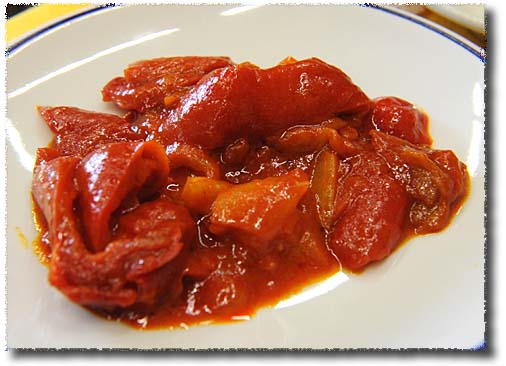Bell Peppers Stuffed with Sausages, Peperoni Ripieni alla Salsiccia
Sausages and bell peppers are a delightful combination, and this recipe will be perfect in spring or autumn, when you want neither the really light dishes of the summer months or the hearty dishes of winter. While you are of course free to use any sort of sausage, I suggest mild sausages.
- 4 bell peppers of the color you prefer; select not-too-large peppers with flat bottoms because they will stand upright more easily
- A scant pound (400 g) sausage meat; remove and discard the casings and crumble the meat
- An egg
- 2 scallions, peeled and chopped
- 3 tablespoons pine nuts
- 1 cup (25-30 g) freshly grated Parmigiano
- A small bunch of parsley
- The leaves from 4 sprigs of fresh thyme
- 1/2 cup dry white wine
- 2 tablespoons olive oil
- Salt and pepper to taste
Preheat your oven to 360 F (180 C).
Finely chop the parsley and the thyme leaves from two of the sprigs. Combine them in a bowl with the egg, sausage meat, and grated cheese, and season the mixture to taste with salt and pepper.
Finely slice the scallions and gently sauté them in 2 tablespoons of olive oil and 2 of water in a non-stick pan, stirring gently. When the water has evaporated add the pine nuts and cook another minute, then let the mixture cool some and add it to the sausage mixture. Mix well.
Wash and dry the peppers, and cut off their tops. Seed them and rib them without puncturing them, and fill them with the sausage mixture, covering them with their tops.
Put the stuffed peppers in a baking dish, drizzle them with the wine and 3 tablespoons of olive oil, cover them with a sheet of aluminum foil, and bake them for 20 minutes. Remove the sheet of aluminum foil and bake them until done, another 20-25 minutes or so.
Let the peppers cool somewhat, garnish them with the remaining thyme leaves, and serve.
The wine? I’d be tempted by a white, perhaps a lusty Sauvignon from Friuli Venezia Giulia.
Yield: 4 servings bell peppers stuffed with sausage meat.

